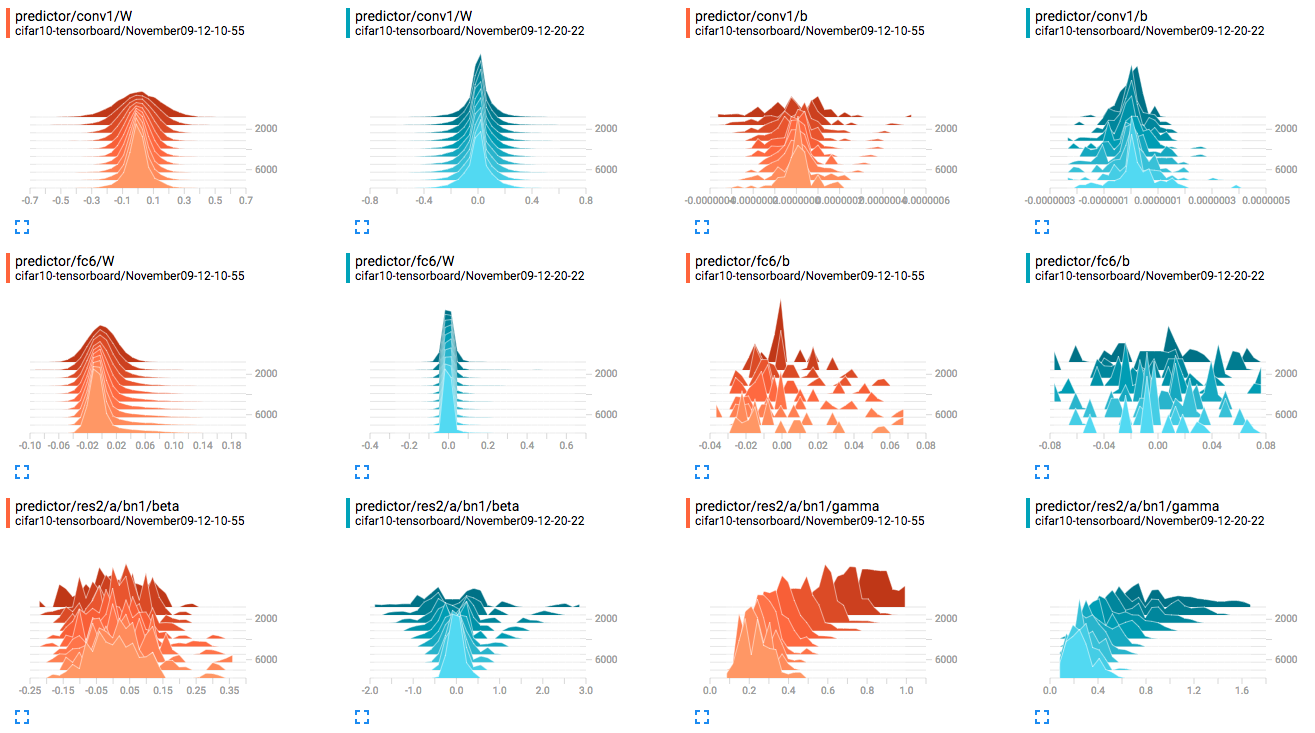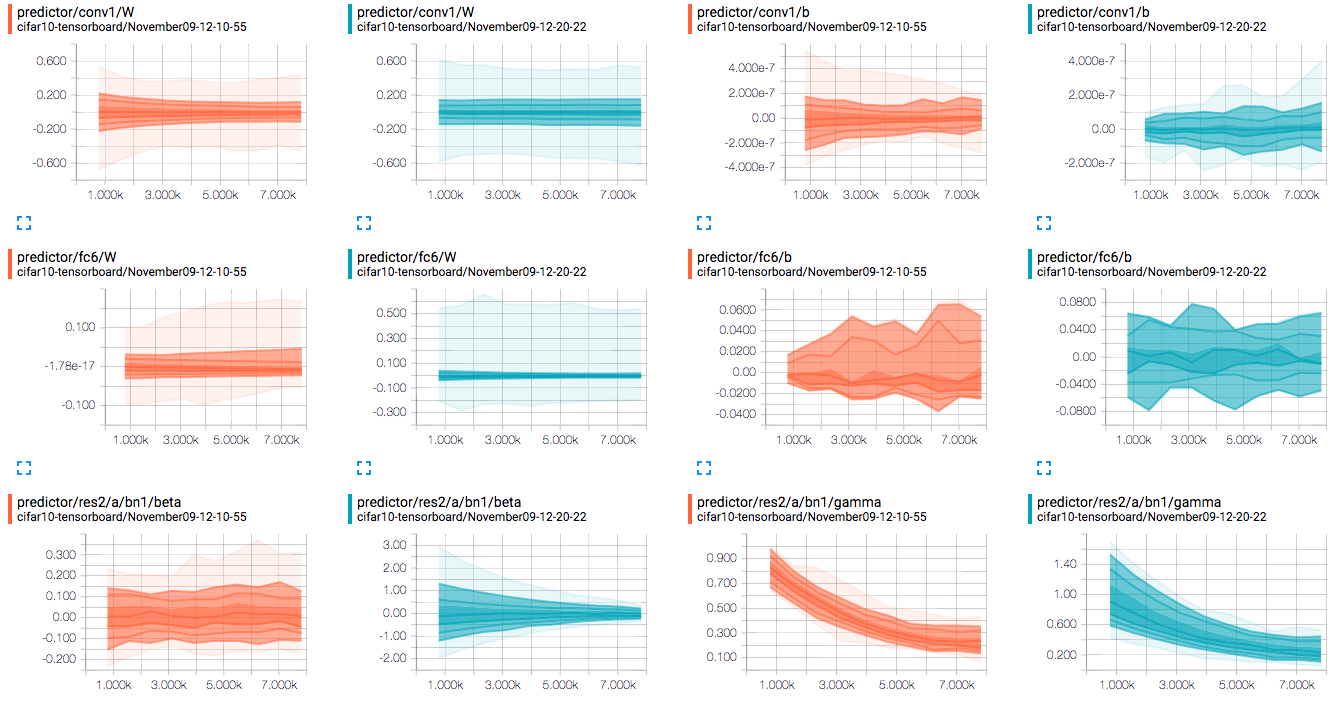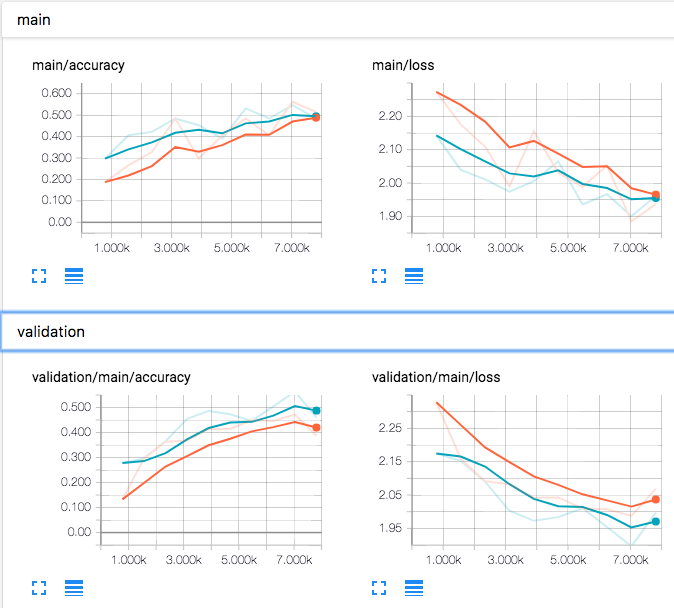tensorboard-chainerを使うのですが、exampleにはTrainerを使った例がなかったので動作を確認するための小さいプログラムを書きました。
from tb_chainer import utils, SummaryWriter
from chainer.training import extensions
from os.path import join
class TensorBoardReport(chainer.training.Extension):
def __init__(self, out_dir):
self.writer = SummaryWriter(join(out_dir, datetime.now().strftime('%B%d-%H-%M-%S')))
def __call__(self, trainer):
observations = trainer.observation
n_iter = trainer.updater.iteration
for n, v in observations.items():
if isinstance(v, chainer.Variable):
value = v.data
elif isinstance(v, chainer.cuda.cupy.ndarray):
value = chainer.cuda.to_cpu(v)
else:
# てきとう
value = v
self.writer.add_scalar(n, value, n_iter)
# とりあえずoptimizerはmainだけ
link = trainer.updater.get_optimizer('main').target
for name, param in link.namedparams():
self.writer.add_histogram(name, chainer.cuda.to_cpu(param.data), n_iter)
とりあえずlossやaccuracyのグラフと、重みパラメータの勾配とヒストグラムだけ書いてみました。
validationのlossやaccuracyを書くためにEvaluatorが動くのと同じサイクルで動かすというごまかしを今回はしました。
tensorboardのimageセクションを使うなどの発展を考えると、このExtensionの中でEvaluationする必要があるか。(保留)
試しに↓のコードで学習を実行してみてログ出力してみました。
ほとんどchainerのcifar10のサンプルのままですが、環境にVGGがダウンロードされてなかったのでresnet50でやりました。
本筋とは関係ないですが、jupyterで実行しているためargsをリストで渡してパースしています。
重みパラメータが学習前後で大きく変わってる方が楽しいなと思ったので、finetuningなしでも試してみました。
from __future__ import print_function
import argparse
from os.path import join
import chainer
import chainer.links as L
from chainer import training
from chainer.training import extensions
from chainer.datasets import get_cifar10
from chainer.datasets import get_cifar100
from chainer.links import ResNet50Layers
class ResNet(chainer.links.ResNet50Layers):
def __call__(self, x):
return super().__call__(x)['prob']
def main(args):
parser = argparse.ArgumentParser(description='Chainer CIFAR example:')
parser.add_argument('--dataset', '-d', default='cifar10',
help='The dataset to use: cifar10 or cifar100')
parser.add_argument('--batchsize', '-b', type=int, default=64,
help='Number of images in each mini-batch')
parser.add_argument('--learnrate', '-l', type=float, default=0.05,
help='Learning rate for SGD')
parser.add_argument('--epoch', '-e', type=int, default=300,
help='Number of sweeps over the dataset to train')
parser.add_argument('--gpu', '-g', type=int, default=0,
help='GPU ID (negative value indicates CPU)')
parser.add_argument('--out', '-o', default='result',
help='Directory to output the result')
parser.add_argument('--resume', '-r', default='',
help='Resume the training from snapshot')
parser.add_argument('--from-scratch', '-s', dest='from_scratch', action='store_true', help='imagenet訓練済みの重みを使わずに学習する')
parser.set_defaults(use_pretrained=False)
args = parser.parse_args(args)
print('GPU: {}'.format(args.gpu))
print('# Minibatch-size: {}'.format(args.batchsize))
print('# epoch: {}'.format(args.epoch))
print('')
# Set up a neural network to train.
# Classifier reports softmax cross entropy loss and accuracy at every
# iteration, which will be used by the PrintReport extension below.
if args.dataset == 'cifar10':
print('Using CIFAR10 dataset.')
class_labels = 10
train, test = get_cifar10()
elif args.dataset == 'cifar100':
print('Using CIFAR100 dataset.')
class_labels = 100
train, test = get_cifar100()
else:
raise RuntimeError('Invalid dataset choice.')
if args.from_scratch:
print('train from scratch')
weight = None
else:
print('finetuning')
weight = 'auto'
resnet = ResNet(weight)
resnet.fc6 = L.Linear(2048, class_labels)
model = L.Classifier(resnet)
if args.gpu >= 0:
# Make a specified GPU current
chainer.cuda.get_device_from_id(args.gpu).use()
model.to_gpu() # Copy the model to the GPU
optimizer = chainer.optimizers.MomentumSGD(args.learnrate)
optimizer.setup(model)
optimizer.add_hook(chainer.optimizer.WeightDecay(5e-4))
train_iter = chainer.iterators.SerialIterator(train, args.batchsize)
test_iter = chainer.iterators.SerialIterator(test, args.batchsize,
repeat=False, shuffle=False)
# Set up a trainer
updater = training.StandardUpdater(train_iter, optimizer, device=args.gpu)
trainer = training.Trainer(updater, (args.epoch, 'epoch'), out=args.out)
# Evaluate the model with the test dataset for each epoch
eval_trigger = (1, 'epoch')
trainer.extend(extensions.Evaluator(test_iter, model, device=args.gpu), trigger=eval_trigger)
# tensorboard Evaluatorを同時に動かすというとりあえず対処
trainer.extend(TensorBoardReport(args.out), trigger=eval_trigger)
# Reduce the learning rate by half every 25 epochs.
trainer.extend(extensions.ExponentialShift('lr', 0.5),
trigger=(25, 'epoch'))
# Dump a computational graph from 'loss' variable at the first iteration
# The "main" refers to the target link of the "main" optimizer.
trainer.extend(extensions.dump_graph('main/loss'))
# Take a snapshot at each epoch
trainer.extend(extensions.snapshot(), trigger=(args.epoch, 'epoch'))
# Write a log of evaluation statistics for each epoch
trainer.extend(extensions.LogReport())
# Print selected entries of the log to stdout
# Here "main" refers to the target link of the "main" optimizer again, and
# "validation" refers to the default name of the Evaluator extension.
# Entries other than 'epoch' are reported by the Classifier link, called by
# either the updater or the evaluator.
trainer.extend(extensions.PrintReport(
['epoch', 'main/loss', 'validation/main/loss',
'main/accuracy', 'validation/main/accuracy', 'elapsed_time']))
# Print a progress bar to stdout
trainer.extend(extensions.ProgressBar())
if args.resume:
# Resume from a snapshot
chainer.serializers.load_npz(args.resume, trainer)
# Run the training
trainer.run()
main(
[
'-d', 'cifar10',
'-o', 'result/cifar10-tensorboard',
'-e', '10',
'-s'
])
main(
[
'-d', 'cifar10',
'-o', 'result/cifar10-tensorboard',
'-e', '10'
])
結果
赤がfinetuningなし、緑がありです。
ヒストグラム。finetuningなしの場合は最初裾野が広かったのが段々シュッとまとまる。

ディストリビューション。これを見てどんな感想を抱けばいいのかな。

勾配が消失するケースとか発散するケースを作って見たほうがいいのかな。
感想
10エポック分のResNet50の重み全部書きだしたらめちゃtensorboard重くなったので、選別しないと死にますね。
